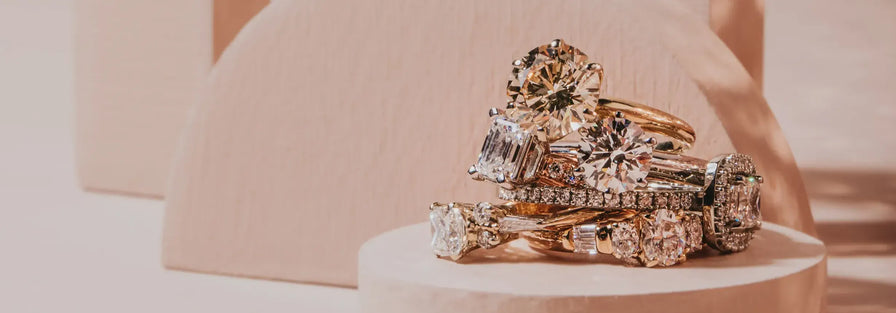Past, Present & Future
Jewellery Care 101:
Take care of your heirlooms, and they will last you an eternity!
Your 100 Ways Jewellery piece has been well taken care of by its previous owner, here’s everything you need to know to ensure your pieces last for more years to come!

How to Store Jewellery
Always store your jewellery pieces individually, preferably in your 100 Ways soft-lined box or pouch or box, so that they don’t rub together, scratch or tangle.
Particular care should be taken with gemstones to ensure that they do not knock against one another when stored.
Also remember to keep your chains fastened so they don’t become tangled.
100 Ways to Care for Your Jewellery
Yellow Gold
When worn regularly, your gold jewellery is exposed to skin oils, perspiration, dust, makeup, and more. To keep its shine, you should clean your jewellery regularly with a solution of 10-parts warm water and 2-parts dish soap. A few extra tips:
- Soaking is the key: You should soak your gold jewellery pieces for 3 hours and then scrub them gently with a very soft brush. Rinse under clean water and blot dry with a cloth.
- Polish: for an extra shine, use a jewellery polishing cloth after this! Do not use a paper towel or tissue as these can scratch your jewellery.
- Clean with soap as needed: by all means, clean your jewellery at home; but, don’t overdo it! Only clean your jewellery as needed when it’s visibly dirty or gathering a patina.
- Other jeweller cleaners: rubbing alcohol is great for cleaning and sanitizing, but stay away from bleach!
- Look out for damage: during your regular jewellery cleanings, be on the lookout for any damage or loose stones. Cleaning damaged pieces can only make the problem worse.
White Gold
White gold is an alloy of gold with nickel or palladium, zinc and copper. It’s a popular type of gold as it’s affordable and in-line with the white-metal trend. Because white gold is rhodium plated it protects the gold underneath from shallow scratching and scuffing
- That extra step: remove any white gold jewellery before you carry out dirty or hands-on tasks.
- No Pools Please: avoid while wearing white gold as the chemicals in the water (chlorine) can react with the plating.
- Before you shower: remove white gold items when bathing and sleeping.
- No mixing metals: keep your white gold away from other metals. For example don't wear a yellow gold ring next to a white gold ring, as the plating may rub off quicker.
Rose Gold
Rose Gold comes from alloying gold with copper. A major perk of rose gold is that it doesn’t tarnish over time. However, just like any gold piece, rose gold jewellery does need to be cleaned and polished from time to time.
- It's easy to maintain: You don't need to get it dipped in anything every few years. When the need arises, simply soak it in mild soap and warm water and then dry with a soft cloth.
PLEASE NOTE: Since so much of rose gold is made of copper, you may get skin irritations and rashes if you're allergic to this alloy
Platinum
Not only is platinum the strongest and purest jewellery metal available, making it especially resistant to chipping and tarnishing - it is also hypoallergenic and a good choice for those with sensitive skin.
- Low maintenance: Although platinum is highly resistant and wears gradually, you should take steps to care for it just as any other precious metal.
- Gentle TLC: using mild soap and warm water is a good replacement — just use your fingers to gently scrub the ring and dry with a lint-free cloth.
Gemstones
Amethyst
Most amethyst is heat treated to bring out best color, but it can crack as well as fade if exposed to high temperatures.
- How to clean: use a damp cloth and gently dry. Warm water and light detergent is also effective.
Aquamarine
Aquamarine also receives heat treatments to bring out its blue color. Heat can still cause color fading.
- How to clean: warm water, detergent, and soft brush
Citrine
Citrine is a heat-treated quartz that will fade when exposed to heat.
- How to clean: use warm water, light detergent, and soft brush to gently clean the surface area.
Emerald
Most emeralds are either bathed in warm oil or have added dye to enhance the color. Thus, mechanical cleaners can potentially cause breakage and should be avoided.
- How to clean: Using warm water and a gentle detergent, lightly brush the surface of the stone with a soft brush
Garnet
Garnets are relatively tough, however they are sensitive to heat and sunlight.
- How to clean: Using warm water and a gentle detergent, lightly brush the surface of the stone with a soft brush
Jade
Jade and nephrite a quite tough and easy to wear. Some stones may have been treated with colour enhancing formulas which could distrupt their strength, so have a professional gemologist examine any pieces to identify treatments. Both jade varieties can take a high lustrous polish.
- How to clean: Using warm water and a gentle detergent, lightly brush the surface of the stone with a soft brush
Lapis Lazuli
Lapis is a porous material that can vary greatly in appearance. It often receives dyes to improve colour. It is sensitive to perfumes, cleaners and other daily products - and can change in appearance with prolonged exposure.
- How to clean: Using warm water and a gentle detergent, lightly brush the surface of the stone with a soft brush
Malachite
Malachite is a striking green that polishes bright but wear can cause its finish to appear dull. Rub briskly with a microfibre cloth to help restore its finish. Please note, malachite is sensitive to acid, ammonia, heat, and hot water.
- How to clean: Using cool water and a gentle detergent, lightly brush the surface of the stone with a soft brush
Opal
Opal is a sensitive and soft stone that requires extra care. Changes in pressure and heat (hot or cold) can causes crazing (surface cracking). Direct sunlight can also affect its brilliance and colour matrix.
- How to clean: Clean gently with mild detergent in warm water using a soft brush or cloth. Bleach, chemicals and cleaning fluid should always be avoided. Doublets and triplets may be wiped with a damp soft cloth and mild detergent, but should never be soaked or immersed.
Peridot
Peridots are sensitive to scratching from household dust (which has a hardness like quartz) and are susceptible to stress fractures. Furthermore, they have some sensitivity to acids, even those found in perspiration and should be worn against the skin only occasionally.
- How to clean: Clean gently with mild detergent in warm water using a soft brush or cloth.
Ruby
Rubies are a stronger stone and can take on daily wear. However, rubies are also subjected to more treatments than almost any other gem; and should still be cleaned gently.
- How to clean: Clean gently with mild detergent in warm water using a soft brush or cloth. Mechanical cleaners can be used but head with caution.
Sapphire
Sapphires are a stronger stone and can take on daily wear. However, sapphires are also subjected to more treatments than almost any other gem; and should still be cleaned gently.
- How to clean: Clean gently with mild detergent in warm water using a soft brush or cloth. Mechanical cleaners can be used but head with caution.
Tanzanite
Heat treatments create this gem’s stunning blue colour. Tanzanite is fragile, relatively soft, and sensitive to heat and vibrations.
- How to clean: Wipe with a damp cloth, then wipe dry immediately.
Turquoise
Turquoise has the tendancy to change tones over time depending on your skin's PH level, and is porous enough to be affected by fragrances and cleaning materials.
- How to clean: Wipe with a damp cloth, then wipe dry immediately.
Topaz
Due to topaz’s perfect cleavage, don’t use ultrasonic or steam systems to clean them. Both vibrations and heat could cause these gems to split. Instead, use a soft brush, mild detergent, and warm water.
- How to clean: Clean gently with a mild detergent in warm water using a soft brush or cloth.
Pearls
Pearls have been valued as gems throughout history and across many cultures. However, these beautiful gems have chemical compositions a bit different than most and require special attention before, during, and after cleaning.
- How to clean: Wet a thin mesh rag with the soap and warm water mixture and carefully wipe the pearls. Dry with a lint-free cloth and wipe off all extra moisture.
- Remove any dirt, grime or grease with a cleaning pen. Soak in a gentle degreasing solution, such as water with a few drops of mild dish soap, once or twice a week. After you remove the diamond from the cleaning solution, use a soft, clean toothbrush to remove any remaining dirt.
Quick Care
Bring back the bling with this premium jewellery cleaning pen that will help your items sparkle and shine!
This magic pen will restore your prized jewellery possession back to its original lustre, as it looked the first day you fell in "love", by conveniently cleaning every nook and cranny including unreachable dust and dirt from any part of your jewels.


